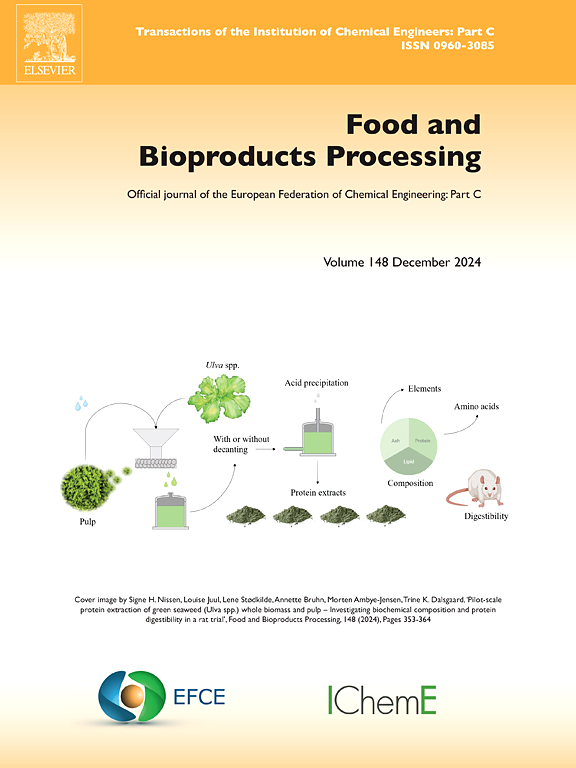Pilot-scale protein extraction of green seaweed (Ulva spp.) whole biomass and pulp – Investigating biochemical composition and protein digestibility in a rat trial
IF 3.5
2区 农林科学
Q2 BIOTECHNOLOGY & APPLIED MICROBIOLOGY
引用次数: 0
Abstract
Ulva, a green seaweed, is gaining interest for food applications due to its high content of protein and well-balanced amino acid composition. However, protein extraction is necessary to reduce the ash content and increase the protein digestibility. In this study, pilot scale protein extraction from Ulva was obtained by a mechanical fractionation, creating a pulp and a juice. A second extraction of protein from the pulp was obtain after a pH shift to 8.5 and the proteins from the two juices were acid precipitated with and without a clearing step (decanting of the resulting juice). Extraction of protein from the whole biomass resulted in a higher content of crude protein (CP) (31.8–37.6 %), essential amino acids (EAA) (42.4 %), and nitrogen digestibility (59.5–63.3 %) than from the pulp (26.1–29.5 % CP of DM, 40.1–40.3 % EAA, 47.4±3.6 % nitrogen digestibility). Including the clearing step increased the protein content but not the nitrogen digestibility (59.5±4.8 % with clearing vs 63.3±3.4 % without). None of the extractions induced cross-linked AA of concern. However, elements were concentrated, where concentrations of arsenic might limit the utilization in food. These results indicate that upscaling of the protein extraction from Ulva is promising, but further improvement regarding toxic elements and protein digestibility is necessary.
试点规模的绿海藻(莼菜属)全生物质和纸浆蛋白质提取--在大鼠试验中调查生化成分和蛋白质消化率
莼菜是一种绿色海藻,因其蛋白质含量高、氨基酸组成均衡而越来越多地被应用于食品领域。然而,要降低灰分含量并提高蛋白质的消化率,就必须进行蛋白质提取。在这项研究中,通过机械分馏从莼菜中提取蛋白质,形成了浆和汁。在将 pH 值调至 8.5 后,对果肉中的蛋白质进行第二次萃取,并对两种果汁中的蛋白质进行酸沉淀,包括清汁步骤和不清汁步骤(倾析所得果汁)。从整个生物质中提取蛋白质后,粗蛋白(CP)含量(31.8-37.6%)、必需氨基酸(EAA)含量(42.4%)和氮消化率(59.5-63.3%)均高于从果肉中提取的蛋白质(DM 的 CP 含量为 26.1-29.5%,EAA 含量为 40.1-40.3%,氮消化率为 47.4±3.6%)。清浆步骤提高了蛋白质含量,但没有提高氮消化率(清浆后为 59.5±4.8 %,未清浆为 63.3±3.4%)。所有萃取方法都不会引起值得关注的交联 AA。然而,元素被浓缩,其中砷的浓度可能会限制其在食物中的利用。这些结果表明,提高从石莼(Ulva)中提取蛋白质的水平是有希望的,但有必要进一步改善有毒元素和蛋白质消化率。
本文章由计算机程序翻译,如有差异,请以英文原文为准。
求助全文
约1分钟内获得全文
求助全文
来源期刊

Food and Bioproducts Processing
工程技术-工程:化工
CiteScore
9.70
自引率
4.30%
发文量
115
审稿时长
24 days
期刊介绍:
Official Journal of the European Federation of Chemical Engineering:
Part C
FBP aims to be the principal international journal for publication of high quality, original papers in the branches of engineering and science dedicated to the safe processing of biological products. It is the only journal to exploit the synergy between biotechnology, bioprocessing and food engineering.
Papers showing how research results can be used in engineering design, and accounts of experimental or theoretical research work bringing new perspectives to established principles, highlighting unsolved problems or indicating directions for future research, are particularly welcome. Contributions that deal with new developments in equipment or processes and that can be given quantitative expression are encouraged. The journal is especially interested in papers that extend the boundaries of food and bioproducts processing.
The journal has a strong emphasis on the interface between engineering and food or bioproducts. Papers that are not likely to be published are those:
• Primarily concerned with food formulation
• That use experimental design techniques to obtain response surfaces but gain little insight from them
• That are empirical and ignore established mechanistic models, e.g., empirical drying curves
• That are primarily concerned about sensory evaluation and colour
• Concern the extraction, encapsulation and/or antioxidant activity of a specific biological material without providing insight that could be applied to a similar but different material,
• Containing only chemical analyses of biological materials.
 求助内容:
求助内容: 应助结果提醒方式:
应助结果提醒方式:


